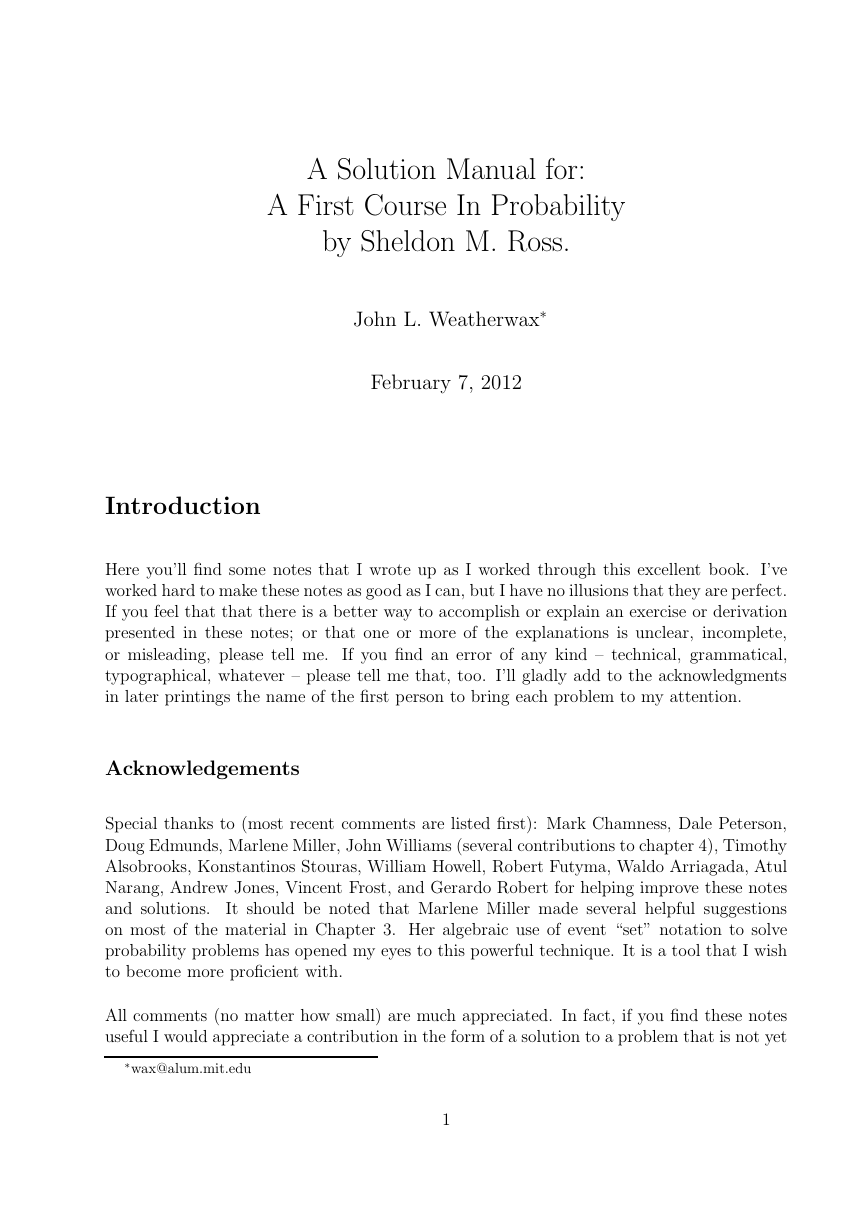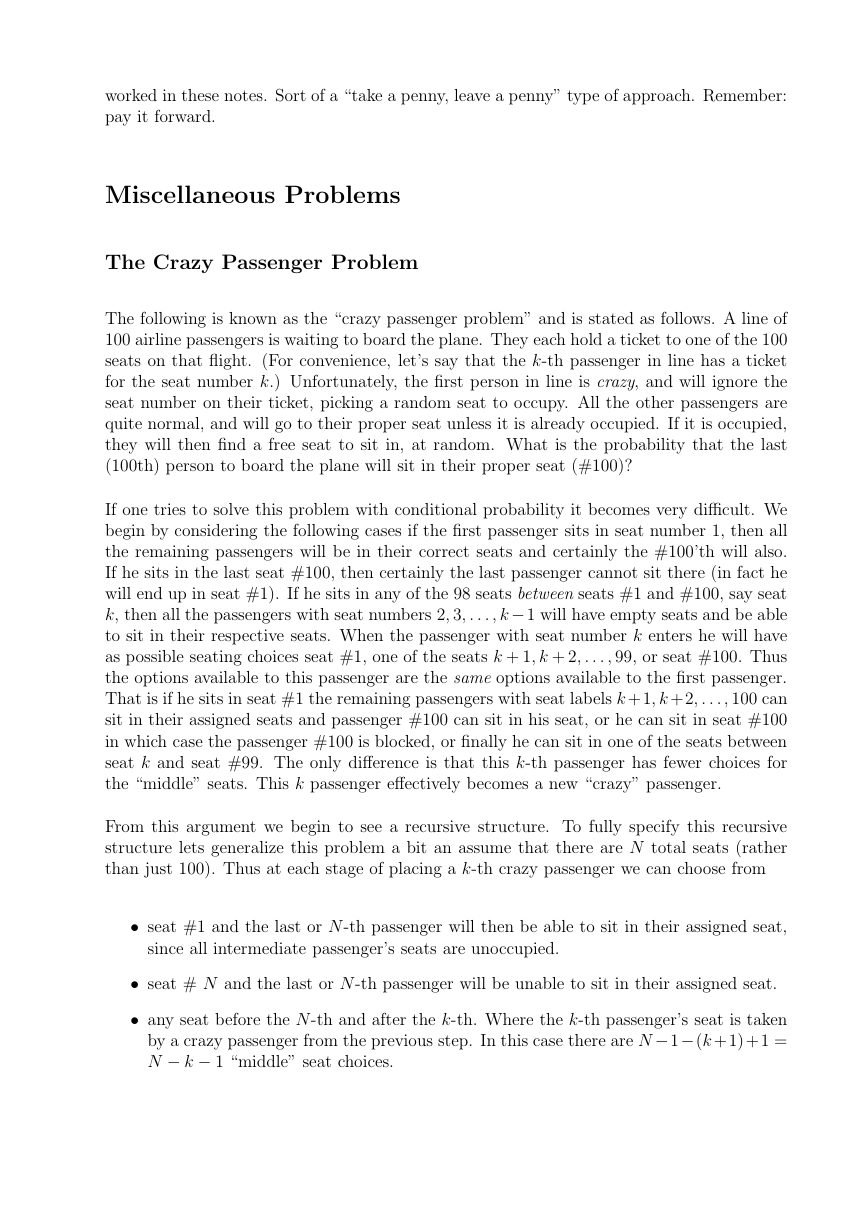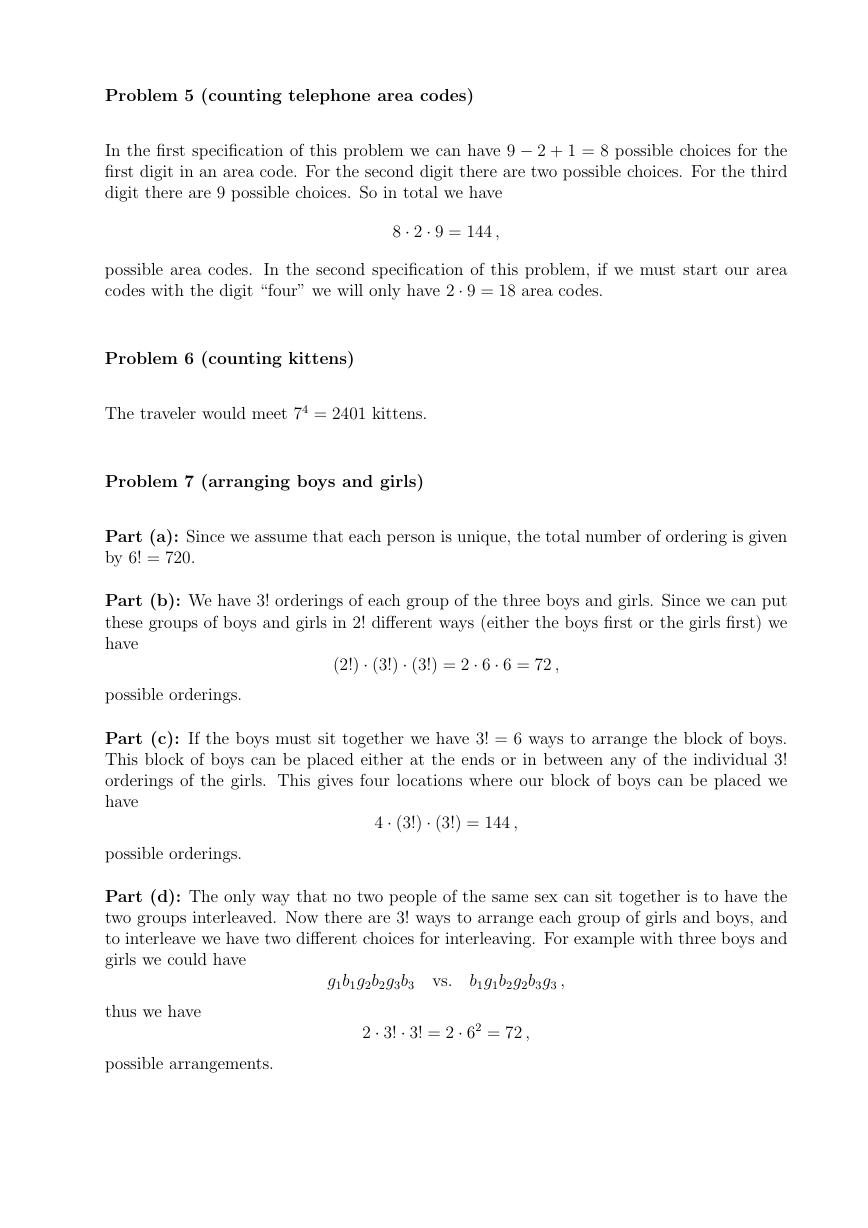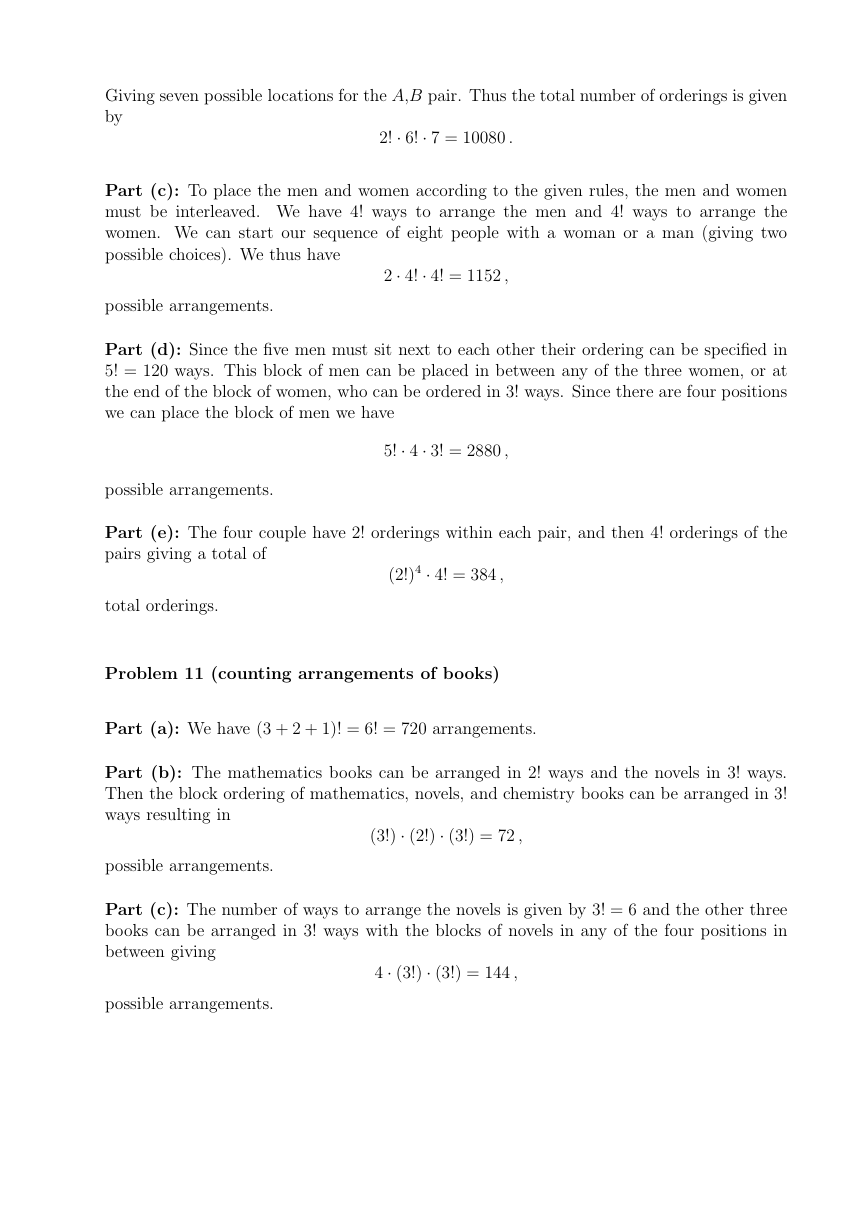A Solution Manual for:
A First Course In Probability
by Sheldon M. Ross.
John L. Weatherwax∗
February 7, 2012
Introduction
Here you’ll find some notes that I wrote up as I worked through this excellent book. I’ve
worked hard to make these notes as good as I can, but I have no illusions that they are perfect.
If you feel that that there is a better way to accomplish or explain an exercise or derivation
presented in these notes; or that one or more of the explanations is unclear, incomplete,
or misleading, please tell me.
If you find an error of any kind – technical, grammatical,
typographical, whatever – please tell me that, too. I’ll gladly add to the acknowledgments
in later printings the name of the first person to bring each problem to my attention.
Acknowledgements
Special thanks to (most recent comments are listed first): Mark Chamness, Dale Peterson,
Doug Edmunds, Marlene Miller, John Williams (several contributions to chapter 4), Timothy
Alsobrooks, Konstantinos Stouras, William Howell, Robert Futyma, Waldo Arriagada, Atul
Narang, Andrew Jones, Vincent Frost, and Gerardo Robert for helping improve these notes
and solutions.
It should be noted that Marlene Miller made several helpful suggestions
on most of the material in Chapter 3. Her algebraic use of event “set” notation to solve
probability problems has opened my eyes to this powerful technique. It is a tool that I wish
to become more proficient with.
All comments (no matter how small) are much appreciated. In fact, if you find these notes
useful I would appreciate a contribution in the form of a solution to a problem that is not yet
∗wax@alum.mit.edu
1
�
worked in these notes. Sort of a “take a penny, leave a penny” type of approach. Remember:
pay it forward.
Miscellaneous Problems
The Crazy Passenger Problem
The following is known as the “crazy passenger problem” and is stated as follows. A line of
100 airline passengers is waiting to board the plane. They each hold a ticket to one of the 100
seats on that flight. (For convenience, let’s say that the k-th passenger in line has a ticket
for the seat number k.) Unfortunately, the first person in line is crazy, and will ignore the
seat number on their ticket, picking a random seat to occupy. All the other passengers are
quite normal, and will go to their proper seat unless it is already occupied. If it is occupied,
they will then find a free seat to sit in, at random. What is the probability that the last
(100th) person to board the plane will sit in their proper seat (#100)?
If one tries to solve this problem with conditional probability it becomes very difficult. We
begin by considering the following cases if the first passenger sits in seat number 1, then all
the remaining passengers will be in their correct seats and certainly the #100’th will also.
If he sits in the last seat #100, then certainly the last passenger cannot sit there (in fact he
will end up in seat #1). If he sits in any of the 98 seats between seats #1 and #100, say seat
k, then all the passengers with seat numbers 2, 3, . . . , k− 1 will have empty seats and be able
to sit in their respective seats. When the passenger with seat number k enters he will have
as possible seating choices seat #1, one of the seats k + 1, k + 2, . . . , 99, or seat #100. Thus
the options available to this passenger are the same options available to the first passenger.
That is if he sits in seat #1 the remaining passengers with seat labels k +1, k +2, . . . , 100 can
sit in their assigned seats and passenger #100 can sit in his seat, or he can sit in seat #100
in which case the passenger #100 is blocked, or finally he can sit in one of the seats between
seat k and seat #99. The only difference is that this k-th passenger has fewer choices for
the “middle” seats. This k passenger effectively becomes a new “crazy” passenger.
From this argument we begin to see a recursive structure. To fully specify this recursive
structure lets generalize this problem a bit an assume that there are N total seats (rather
than just 100). Thus at each stage of placing a k-th crazy passenger we can choose from
• seat #1 and the last or N-th passenger will then be able to sit in their assigned seat,
since all intermediate passenger’s seats are unoccupied.
• seat # N and the last or N-th passenger will be unable to sit in their assigned seat.
• any seat before the N-th and after the k-th. Where the k-th passenger’s seat is taken
by a crazy passenger from the previous step. In this case there are N −1−(k + 1) + 1 =
N − k − 1 “middle” seat choices.
�
If we let p(n, 1) be the probability that given one crazy passenger and n total seats to select
from that the last passenger sits in his seat. From the argument above we have a recursive
structure give by
p(N, 1) =
=
1
N
1
N
(1) +
1
N
(0) +
p(N − k, 1)
N−1
1
N
Xk=2
p(N − k, 1) .
+
1
N
N−1
Xk=2
where the first term is where the first passenger picks the first seat (where the N will sit
correctly with probability one), the second term is when the first passenger sits in the N-th
seat (where the N will sit correctly with probability zero), and the remaining terms represent
the first passenger sitting at position k, which will then require repeating this problem with
the k-th passenger choosing among N − k + 1 seats.
To solve this recursion relation we consider some special cases and then apply the principle
of mathematical induction to prove it. Lets take N = 2. Then there are only two possible
arrangements of passengers (1, 2) and (2, 1) of which one (the first) corresponds to the second
passenger sitting in his assigned seat. This gives
p(2, 1) =
1
2
.
If N = 3, then from the 3! = 6 possible choices for seating arrangements
(1, 2, 3) (1, 3, 2) (2, 3, 1) (2, 1, 3) (3, 1, 2) (3, 2, 1)
Only
(1, 2, 3) (2, 1, 3) (3, 2, 1)
correspond to admissible seating arrangements for this problem so we see that
p(3, 1) =
3
6
=
1
2
.
If we hypothesis that p(N, 1) = 1
formulation above gives
2 for all N, placing this assumption into the recursive
p(N, 1) =
1
N
+
1
N
1
2
=
1
2
.
N−1
Xk=2
Verifying that indeed this constant value satisfies our recursion relationship.
�
Chapter 1 (Combinatorial Analysis)
Chapter 1: Problems
Problem 1 (counting license plates)
Part (a): In each of the first two places we can put any of the 26 letters giving 262 possible
letter combinations for the first two characters. Since the five other characters in the license
plate must be numbers, we have 105 possible five digit letters their specification giving a
total of
total license plates.
262 · 105 = 67600000 ,
Part (b): If we can’t repeat a letter or a number in the specification of a license plate then
the number of license plates becomes
26 · 25 · 10 · 9 · 8 · 7 · 6 = 19656000 ,
total license plates.
Problem 2 (counting die rolls)
We have six possible outcomes for each of the die rolls giving 64 = 1296 possible total
outcomes for all four rolls.
Problem 3 (assigning workers to jobs)
Since each job is different and each worker is unique we have 20! different pairings.
Problem 4 (creating a band)
If each boy can play each instrument we can have 4! = 24 ordering. If Jay and Jack can
play only two instruments then we will assign the instruments they play first with 2! possible
orderings. The other two boys can be assigned the remaining instruments in 2! ways and
thus we have
possible unique band assignments.
2! · 2! = 4 ,
�
Problem 5 (counting telephone area codes)
In the first specification of this problem we can have 9 − 2 + 1 = 8 possible choices for the
first digit in an area code. For the second digit there are two possible choices. For the third
digit there are 9 possible choices. So in total we have
8 · 2 · 9 = 144 ,
possible area codes. In the second specification of this problem, if we must start our area
codes with the digit “four” we will only have 2 · 9 = 18 area codes.
Problem 6 (counting kittens)
The traveler would meet 74 = 2401 kittens.
Problem 7 (arranging boys and girls)
Part (a): Since we assume that each person is unique, the total number of ordering is given
by 6! = 720.
Part (b): We have 3! orderings of each group of the three boys and girls. Since we can put
these groups of boys and girls in 2! different ways (either the boys first or the girls first) we
have
possible orderings.
(2!) · (3!) · (3!) = 2 · 6 · 6 = 72 ,
Part (c): If the boys must sit together we have 3! = 6 ways to arrange the block of boys.
This block of boys can be placed either at the ends or in between any of the individual 3!
orderings of the girls. This gives four locations where our block of boys can be placed we
have
possible orderings.
4 · (3!) · (3!) = 144 ,
Part (d): The only way that no two people of the same sex can sit together is to have the
two groups interleaved. Now there are 3! ways to arrange each group of girls and boys, and
to interleave we have two different choices for interleaving. For example with three boys and
girls we could have
thus we have
possible arrangements.
g1b1g2b2g3b3 vs.
b1g1b2g2b3g3 ,
2 · 3! · 3! = 2 · 62 = 72 ,
�
Problem 8 (counting arrangements of letters)
Part (a): Since “Fluke” has five unique letters we have 5! = 120 possible arrangements.
Part (b): Since “Propose” has seven letters of which four (the “o”’s and the “p”’s) repeat
we have
arrangements.
7!
2! · 2!
= 1260 ,
Part (c): Now “Mississippi” has eleven characters with the “i” repeated four times, the “s”
repeated four times and the “p” repeated two times, so we have
possible rearranges.
11!
4! · 4! · 2!
= 34650 ,
Part (d): “Arrange” has seven characters with a double “a” and a double “r” so it has
7!
2! · 2!
= 1260 ,
different arrangements.
Problem 9 (counting colored blocks)
Assuming each block is unique we have 12! arrangements, but since the six black and the
four red blocks are not distinguishable we have
12!
6! · 4!
= 27720 ,
possible arrangements.
Problem 10 (seating people in a row)
Part (a): We have 8! = 40320 possible seating arrangements.
Part (b): We have 6! ways to place the people (not including A and B). We have 2! ways
to order A and B. Once the pair of A and B is determined, they can be placed in between
any ordering of the other six. For example, any of the “x”’s in the expression below could
be replaced with the A B pair
x P1 x P2 x P3 x P4 x P5x P6 x .
�
Giving seven possible locations for the A,B pair. Thus the total number of orderings is given
by
2! · 6! · 7 = 10080 .
Part (c): To place the men and women according to the given rules, the men and women
must be interleaved. We have 4! ways to arrange the men and 4! ways to arrange the
women. We can start our sequence of eight people with a woman or a man (giving two
possible choices). We thus have
possible arrangements.
2 · 4! · 4! = 1152 ,
Part (d): Since the five men must sit next to each other their ordering can be specified in
5! = 120 ways. This block of men can be placed in between any of the three women, or at
the end of the block of women, who can be ordered in 3! ways. Since there are four positions
we can place the block of men we have
possible arrangements.
5! · 4 · 3! = 2880 ,
Part (e): The four couple have 2! orderings within each pair, and then 4! orderings of the
pairs giving a total of
total orderings.
(2!)4 · 4! = 384 ,
Problem 11 (counting arrangements of books)
Part (a): We have (3 + 2 + 1)! = 6! = 720 arrangements.
Part (b): The mathematics books can be arranged in 2! ways and the novels in 3! ways.
Then the block ordering of mathematics, novels, and chemistry books can be arranged in 3!
ways resulting in
possible arrangements.
(3!) · (2!) · (3!) = 72 ,
Part (c): The number of ways to arrange the novels is given by 3! = 6 and the other three
books can be arranged in 3! ways with the blocks of novels in any of the four positions in
between giving
possible arrangements.
4 · (3!) · (3!) = 144 ,
�
Problem 12 (counting awards)
Part (a): We have 30 students to choose from for the first award, and 30 students to choose
from for the second award, etc. So the total number of different outcomes is given by
305 = 24300000
Part (b): We have 30 students to choose from for the first award, 29 students to choose
from for the second award, etc. So the total number of different outcomes is given by
30 · 29 · 28 · 27 · 26 = 17100720
Problem 13 (counting handshakes)
With 20 people the number of pairs is given by
2 = 190 .
20
Problem 14 (counting poker hands)
A deck of cards has four suits with thirteen cards each giving in total 52 cards. From these
52 cards we need to select five to form a poker hand thus we have
52
5 = 2598960 ,
unique poker hands.
Problem 15 (pairings in dancing)
We must first choose five women from ten in 10
in 12
5 possible ways, and five men from 12
5 ways. Once these groups are chosen then we have 5! pairings of the men and
women. Thus in total we will have
10
5 12
5 5! = 252 · 792 · 120 = 23950080 ,
possible pairings.
�
















 2023年江西萍乡中考道德与法治真题及答案.doc
2023年江西萍乡中考道德与法治真题及答案.doc 2012年重庆南川中考生物真题及答案.doc
2012年重庆南川中考生物真题及答案.doc 2013年江西师范大学地理学综合及文艺理论基础考研真题.doc
2013年江西师范大学地理学综合及文艺理论基础考研真题.doc 2020年四川甘孜小升初语文真题及答案I卷.doc
2020年四川甘孜小升初语文真题及答案I卷.doc 2020年注册岩土工程师专业基础考试真题及答案.doc
2020年注册岩土工程师专业基础考试真题及答案.doc 2023-2024学年福建省厦门市九年级上学期数学月考试题及答案.doc
2023-2024学年福建省厦门市九年级上学期数学月考试题及答案.doc 2021-2022学年辽宁省沈阳市大东区九年级上学期语文期末试题及答案.doc
2021-2022学年辽宁省沈阳市大东区九年级上学期语文期末试题及答案.doc 2022-2023学年北京东城区初三第一学期物理期末试卷及答案.doc
2022-2023学年北京东城区初三第一学期物理期末试卷及答案.doc 2018上半年江西教师资格初中地理学科知识与教学能力真题及答案.doc
2018上半年江西教师资格初中地理学科知识与教学能力真题及答案.doc 2012年河北国家公务员申论考试真题及答案-省级.doc
2012年河北国家公务员申论考试真题及答案-省级.doc 2020-2021学年江苏省扬州市江都区邵樊片九年级上学期数学第一次质量检测试题及答案.doc
2020-2021学年江苏省扬州市江都区邵樊片九年级上学期数学第一次质量检测试题及答案.doc 2022下半年黑龙江教师资格证中学综合素质真题及答案.doc
2022下半年黑龙江教师资格证中学综合素质真题及答案.doc